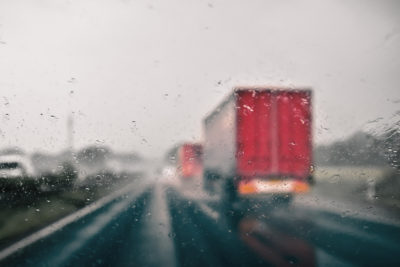

Sometimes, however, avoiding flooded areas simply is not possible. Here is what you should do if you are driving through a flooded road.
Avoid Standing Water If You Possibly Can
It bears repeating: it really is best to avoid driving through standing water if you reasonably can. You may be driving a truck, but your vehicle is still vulnerable to the hazards of the road. If you can switch lanes or take an alternate route, do that first before attempting to drive through a flood.
A good rule of thumb is to avoid standing water that is more than six inches deep. Of course, the danger of this is that water often is much deeper than it appears.
Take It As Slow As Possible
If you decide that you should continue driving (or if it is simply necessary), drive as slowly as possible. Driving below five miles an hour in severe flooding is not out of the question. Drive as close to the shoulder as you can. This will help raise your vehicle onto slightly higher ground.
When you first enter the flooded area, keep your vehicle speed at one to two miles per hour. Then, accelerate up to four miles per hour. This helps push the water out in a bow in front of your vehicle. It will also help hold water out of your engine bay and avoid flooding your engine.
Another reason to drive slowly is to reduce your risk of hydroplaning. This can happen even to large vehicles. This phenomenon occurs when cars drive too quickly over standing water. The tires lift off the ground, causing the vehicle to drift or slide, often uncontrollably.
Don’t Think It’s Over When You’re on Dry Ground
Water damage to your vehicle can happen even after you are back on solid ground. When you are out of the flooded area, make sure to gently tap your brakes regularly to dry them out. Brakes that are left wet can lead to rust and damage. If you regularly drive through flooded areas, it may be a good idea to have your vehicle inspected more than you normally would.
Watch Out for Other Drivers
As always, be wary of other drivers. Leave twice as much room between your vehicle and the car in front of you as you normally would. Unfortunately, it is better to consider other drivers as less-experienced drivers instead of assuming that all your fellow travelers are prudent and responsible and be able to plan around that.
Do not underestimate the damage another imprudent driver can make on your own vehicle. Cars driving quickly are more liable to get stuck in standing water, creating road blockages and hazards. They also may hydroplane and slide into traffic. For this reason, it is important to be wary and watch other drivers as you travel through flooded areas.
Standing water can be dangerous, but moving water is downright deadly. You should never attempt to cross an area with flowing floodwaters. They are much stronger than they appear and have the potential to sweep vehicles away with little warning. You may be driving a large vehicle, but it is still important to practice prudence.






